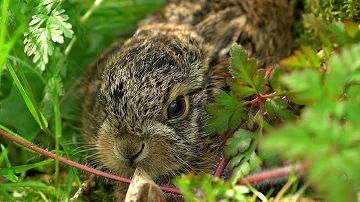
Hispid Hare
Caprolagus hispidus

Meet the Hispid Hare
The Hispid Hare, also known as the Assam Rabbit or Bristly Rabbit, is a rare and elusive species of hare native to the foothills of the Himalayas in South Asia. Recognized for its coarse, bristly fur and compact build, this small mammal is adapted to live in tall grasslands and reed beds. The species is highly secretive, making sightings extremely uncommon, and spends much of its time concealed within dense vegetation. Habitat loss, fragmentation, and human encroachment have led to a dramatic decline in its population, pushing the species towards the brink of extinction.
Classification
Mammal
Habitat
Tall grasslands
Diet
Herbivore
Lifespan
4-6 years
Conservation
Endangered
Weight
2-2.5 kg
📖Fascinating Facts
Grassland Specialist
The Hispid Hare is highly specialized for life in dense, tall grasslands, which provide both food and shelter from predators.
Unique Coat
Its bristly, coarse fur sets it apart from other hares and provides excellent camouflage among reeds and grasses.
Rediscovered Species
The Hispid Hare was thought to be extinct for decades until it was rediscovered in the 1970s, highlighting the importance of ongoing wildlife surveys.
📋Detailed Description
The hispid hare (Caprolagus hispidus) is a medium-sized lagomorph, measuring 38–50 cm in length and weighing between 2.0–2.5 kg. Its most distinctive feature is its coarse, bristly fur, which is dark brown to blackish on the dorsal surface and lighter on the ventral side, providing effective camouflage in dense grasslands. The head is broad with a prominent, blunt nose, and the ears are notably short (2.6–7.2 cm), much shorter than those of sympatric hares such as Lepus nigricollis. The limbs are relatively short, and the hind feet are robust, aiding in movement through thick vegetation. Hispid hares are primarily crepuscular and nocturnal, remaining concealed during the day in shallow forms or tunnels within grass clumps. They are solitary and highly elusive, rarely seen in the open. The species is adapted to the tall, early successional grasslands of the Himalayan foothills and adjacent plains, often in areas subject to periodic flooding and fire. Their diet consists mainly of grasses, shoots, roots, and occasionally agricultural crops. The hispid hare is the sole member of its genus, representing a unique evolutionary lineage within the family Leporidae. Its secretive nature, specialized habitat requirements, and low population density make it one of the least observed and studied lagomorphs in the world.
💡 Did you know?
The Hispid Hare is one of the world's rarest lagomorphs and is considered a 'living fossil' because its lineage dates back to the Pleistocene epoch.
🔬Research & Sources
Wikipedia Summary
The hispid hare, also known as the Assam rabbit and bristly rabbit, is a species of rabbit native to South Asia. It is the only species in the genus Caprolagus. Named for its bristly fur coat, the hispid hare is a rabbit with dark-brown fur and a large nose. It has small ears compared to the Indian hare, a lagomorph that occurs in the same regions as the hispid hare.
Last Modified: 6/10/2025
🎭Behavior & Social Structure
Hispid hares are solitary and display strong territoriality, with individuals occupying and defending overlapping home ranges. They are predominantly crepuscular, emerging at dawn and dusk to feed, though activity patterns may shift in response to human disturbance or predation risk. During the day, they rest in shallow depressions or forms, well-concealed within dense grass or reed beds. When threatened, they rely on their cryptic coloration and stillness to avoid detection, resorting to rapid, zigzag running only as a last resort. Feeding behavior is selective; they graze on a variety of grasses, sedges, and tender shoots, and have been observed to consume roots and tubers during the dry season. Unlike many other lagomorphs, hispid hares rarely dig burrows, instead utilizing natural cover for shelter. Social interactions are minimal outside of the breeding season, and vocalizations are rare, though they may thump their hind feet as an alarm signal.
👶Reproduction & Life Cycle
The breeding season of the hispid hare is not well documented but is believed to coincide with the onset of the monsoon (March to September), when food resources are abundant. Females construct simple nests or forms in dense grass, where they give birth to litters typically comprising 2–4 leverets. The gestation period is estimated to be around 30 days, similar to other Leporidae. Leverets are born fully furred and with eyes open, a trait known as precocial development, enabling them to move and hide soon after birth. Maternal care is brief; the female visits the nest infrequently to nurse, minimizing the risk of attracting predators. There is little evidence of paternal involvement. Juveniles reach independence within a few weeks and may disperse to establish their own territories.
🛡️Adaptations & Survival
The hispid hare exhibits several adaptations to its grassland habitat. Its bristly, coarse fur provides both camouflage and protection against abrasive grasses and undergrowth. The short ears reduce heat loss and minimize the risk of injury while moving through dense vegetation. Robust hind limbs and feet facilitate rapid movement and sudden changes in direction, aiding escape from predators. Behaviorally, their secretive and crepuscular habits reduce exposure to both predators and human disturbance. Their digestive system is adapted for a high-fiber diet, efficiently processing tough grasses and sedges. The species' ability to utilize early successional habitats, often created by fire or flooding, is a key ecological specialization, though it also makes them vulnerable to habitat changes.
🎨Cultural Significance
The hispid hare has limited direct cultural significance, largely due to its rarity and secretive behavior. In some local traditions, it is occasionally referenced as a symbol of the wild grasslands, but it does not feature prominently in folklore or mythology. There are sporadic reports of its use in traditional medicine, but these are not widespread. Its status as a flagship species for grassland conservation has grown in recent years, with conservationists using its plight to highlight the importance of preserving the last remnants of the South Asian Terai grasslands.
🔬Recent Research & Discoveries
Recent research has focused on habitat use, population genetics, and the impacts of grassland management practices on hispid hare survival. Camera trapping and genetic sampling have improved understanding of its distribution and population structure, revealing greater fragmentation than previously thought. Studies in Chitwan National Park and Dudhwa National Park have highlighted the importance of controlled burning and grazing in maintaining suitable habitat. Ongoing research aims to develop landscape-level conservation strategies and to assess the potential for habitat corridors between isolated populations. The species remains difficult to study due to its cryptic nature, and further ecological and behavioral research is urgently needed.
🎥Wildlife Videos

Woodland and grassland habitat of the endangered Hispid Hare
This moist light forest and grassland is the sort of habitat preferred by the endangered Hispid Hare. This footage is part of the ...
WildFilmsIndia

How Baby Animals Survive in the Wild | HD Nature Documentary
The first months of a wild animal's life are full of challenges. From seal pups on stormy coastlines to bear cubs emerging from ...
Terra Mater

Croatia's Secret Animal Paradise | Free Documentary Nature
Croatia's Secret Animal Paradise | Nature Documentary Watch 'Wild Germany: The Mecklenburg Lake Plateau' here: ...
Free Documentary - Nature

30 Most Beautiful Creatures On Earth (Order Galliformes) | Wildlife Documentary | BBTV Official
In the heart of the world's most remote forests and rugged highlands, where mist lingers over ancient trees and the wilderness ...
BBTV Official

Hare Raises Baby Leveret in My Back Garden | Discover Wildlife | Robert E Fuller
I've been studying hares on the Yorkshire Wolds for years and I saw something near my studio that I've never seen before. A baby ...
Robert E Fuller

WILD PATAGONIA | The Mysteries of Earth's Last Untamed Ecosystem | Animal Documentary
Patagonia, a vast and windswept region straddling the southernmost reaches of South America, is one of the planet's most ...
WILD Nature - Free Documentary
🌍Habitat Information
The Hispid Hare typically inhabits Tall grasslands environments. Hispid Hares have adapted to their environments with specialized features and behaviors.
Primary Habitat:
Tall grasslands
More detailed habitat information will be available soon.
🛡️Conservation Status
The Hispid Hare is currently classified as Endangered. Conservation efforts are crucial for preserving this species for future generations.
Common Threats:
- 🏠Habitat loss and fragmentation
- 🌡️Climate change impacts
- 🎯Hunting and poaching
- 🏭Human-wildlife conflict
⚠️Threats & Conservation Challenges
The primary threats to the hispid hare are habitat loss and fragmentation due to agricultural expansion, human settlement, and infrastructure development. The conversion of tall grasslands to cropland and the suppression of natural fire regimes have drastically reduced suitable habitat. Overgrazing by livestock and invasive plant species further degrade grassland quality. The species is also threatened by accidental burning during the breeding season, which can destroy nests and leverets. Poaching for meat and traditional medicine, though less common, poses an additional risk. Population estimates are uncertain but suggest a continuing decline, with the species now surviving in isolated pockets within protected areas in Nepal, northern India, and possibly Bhutan and Bangladesh. Its restricted range, low reproductive rate, and specialized habitat requirements make recovery challenging.
🔬Scientific Classification
Scientific Name
Caprolagus hispidus
Classification Hierarchy
🔍 About Taxonomic Classification
Taxonomic classification is a hierarchical system used by scientists to classify and organize living organisms based on shared characteristics and evolutionary relationships.
The system moves from broad categories (Kingdom) to increasingly specific ones, with each animal's scientific name typically consisting of its Genus and species.
📝Community Notes
Share your observations and insights about the Hispid Hare with our community of wildlife enthusiasts.
Join Our Community
Sign in to share your observations and connect with fellow wildlife enthusiasts.
Sign In to ContributeNo community notes yet
Be the first to share your observations about the Hispid Hare!
Explore Hispid Hare
Select a tab above to learn more about this amazing animal.
📸Photo Gallery
No photos available for this animal yet.
🌟Discover More Wildlife
Continue your journey of discovery with more fascinating animals from our database
